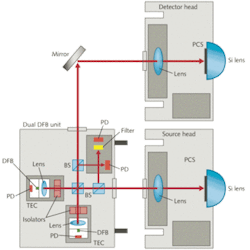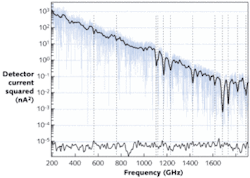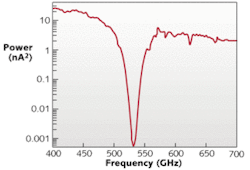TERAHERTZ SOURCES: Photonic integration improves heterodyne photomixing terahertz sources
RONALD T. LOGAN JR. and JOSEPH R. DEMERS
One of the more promising approaches for production and detection of tunable terahertz radiation with large scanning bandwidths and good signal-to-noise ratios is based on photomixing in photoconductive switch (PCS) devices fabricated in low-temperature-grown gallium arsenide (GaAs) and erbium arsenide:gallium arsenide (ErAs:GaAs).1 Time-domain photomixing techniques produce a broadband spectrum of frequency components with limited frequency resolution, so new methods are being developed to advance more-sensitive frequency-domain terahertz techniques.
In the frequency-domain technique, continuous-wave (CW) terahertz radiation is produced through photomixing of the combined output of two single-frequency diode lasers in a PCS. In this heterodyne approach, the wavelength of one (or both) of the lasers is tuned to vary the terahertz output frequency.
Coherent (homodyne) detection of terahertz signals can be achieved at room temperature by mixing the same optical radiation from the heterodyne diode lasers in a detector PCS onto which the terahertz signal is also incident.2, 3 This provides greater sensitivity and faster data acquisition than incoherent detection techniques using room-temperature Golay cell detectors, and preserves phase information with noise-equivalent power levels equal to or better than 10-12 W/Hz.
Tunable single-frequency terahertz sources are desired for spectroscopic applications such as explosives detection. Benefits of the coherent frequency-domain spectroscopy compared to the time-domain technique are that it has no moving parts (no mechanical scanning delay line), offers higher frequency resolution, and has the ability to selectively scan specific frequency regions of interest with adjustable resolution. Also, unlike time-domain systems, CW frequency-domain photomixing results in all of the terahertz power being concentrated at a single terahertz frequency, thus improving spectral density and signal-to-noise ratio (S/N) at that frequency.
Dual-laser control
Despite these advantages, it has been difficult to realize practical frequency-domain terahertz spectrometers because of the challenges associated with the construction and control of the dual lasers—namely mode-matching and co-collimation of the two laser beams and precise control of their difference frequency. Emcore is addressing these challenges through careful attention to the diode-laser packaging and the use of digital signal processing for accurate laser control.
The key component is a highly integrated dual semiconductor-laser module designed specifically for this application. The module contains two distributed-feedback (DFB) laser-diode chips mounted on independent Peltier thermoelectric coolers (TECs; see Fig. 1). The center wavelengths of the DFB lasers are nominally 783 nm at 25°C, but the wavelengths can be temperature-tuned over 2.5 nm (1.25 THz), resulting in a difference frequency of more than 2.5 THz without mode hops. The thermal mass on the controlled surface of the TECs is kept to a minimum to allow for rapid frequency tuning.
The output from each laser is collimated with an aspheric lens on a precision lens mount with submicron adjustment capability.4, 5 A 50/50 beamsplitter co-collimates the beams into primary and secondary beams at right angles to each other. The lenses and the beamsplitter are adjusted so that the beam overlap is maximized. The free-space optical outputs of the dual DFB unit are focused onto source and detector PCS devices in a coherent homodyne detection configuration. Free-space optical beams provide the highest efficiency of optical coupling to the photomixer devices, permitting the highest output power and detection sensitivity possible. It is also possible to couple the outputs of the dual-DFB unit to optical fibers to deliver the laser signals to remotely located photomixers, but with correspondingly higher optical losses.
Indirect frequency measurement
A crucial aspect of photomixing spectroscopy is frequency metrology. Direct measurement of the terahertz frequency is not practical due to the extremely high frequencies involved and the lack of commercial diagnostic tools. Therefore, a compact optical spectrometer is integrated with the lasers to permit accurate measurement of the relative laser frequencies. Approximately 10% of the primary beam is coupled through a thin-film optical filter on a TEC element that has a predetermined wavelength profile and is then incident on a photodiode. The same amount of power is coupled out of the secondary beam and is incident on an unfiltered photodiode. Because the two DFB lasers are current-modulated at slightly different frequencies, it is possible to distinguish individual power levels on the filtered and nonfiltered photodiodes with a simple frequency-sensitive slope-detection technique. Control of the filter TEC to better than 0.1°C provides absolute frequency accuracy of approximately 50 MHz.
Comparison of the relative amplitudes of the lasers on these two photodiodes with respect to the calibrated wavelength indicates their respective wavelengths to within approximately 100 MHz. After photomixing, this translates into a terahertz frequency accuracy of approximately 200 MHz. The full-width half-maximum (FWHM) linewidth of the photomixing signal is less than 20 MHz, limited by the instantaneous linewidths of the DFB lasers. This level of stability is more than adequate for investigation of solid-phase materials and gases at atmospheric pressure.
Another important aspect is the quality of the PCS devices. The active region of Emcore’s devices consists of ErAs nanoparticles embedded in a GaAs matrix. The electrical bias and terahertz photocurrents are coupled through interdigital electrodes fabricated on the top surface and located in the driving gap of a three-turn self-complementary square spiral antenna.6 The photomixers are qualified through their dark current (approximately 1 µA) and 780 nm optical responsivity (approximately 0.015 A/W) at 25 V bias.
After characterization of the lasers and PCS devices, the dual DFB photonic module is placed inside a terahertz head unit that houses control electronics, focusing optics, and the source PCS. The PCS is mounted on a hyperhemispherical silicon lens that is part of the head unit. Optics focus the primary beam from the dual DFB photonic module onto the source PCS, the bias of which is electronically “chopped” with a 25 kHz square wave at ± 25 V. This technique is only possible with coherent, phase-sensitive detection and yields a 3 dB improvement in terahertz output power compared to conventional mechanical chopping of the input laser beam. Furthermore, the 25 kHz frequency is much higher than a mechanical chopper, which moves the detection frequency away from 1/f noise processes and permits significantly higher data-acquisition bandwidths than with thermal detectors.
Terahertz source measurements
The output power spectrum of the terahertz source as measured on a calibrated Golay cell is 10 to 20 µW at 100 GHz, and 2 µW at 1 THz. The S/N of the spectrometer can be illustrated by showing the detected power spectrum for a 1 ft path length in air with approximately 1 GHz frequency resolution and 1 s integration time on the lock-in amplifier (see Fig. 2). The rapid variation in the unsmoothed signal amplitude versus frequency is expected, and is due to the phase-unbalanced interferometric configuration of the spectrometer. In future work, this signal will be processed to extract phase information from the interferogram.It should be noted that a S/N of approximately 80 dB*Hz is obtained at 100 GHz. The high S/N is mostly attributed to improved optical beam collimation and overlap in the integrated laser assembly, as well as improved optical and terahertz coupling of the current device.
After system characterization, Emcore’s PB7100 terahertz spectrometer system was used to characterize several compounds. One of the first compounds measured was lactose monohydrate, which is a solid with a very strong absorption at 535 GHz (see Fig. 3). The powder was prepared by placing it in the center of a large metal washer and holding it in place with clear plastic adhesive tape on both sides. The data was collected with a 1 s integration time, a 500 MHz resolution, and a 25-point running average to remove the interference pattern. The five-decade dynamic range of the PB7100 at these frequencies is clear. The measured FWHM of the absorption feature is difficult to determine on a logarithmic plot but is approximately 25 GHz, similar to previously published results.7ACKNOWLEDGMENTS
We would like to thank Dwight Woolard of the U.S. Army Research Office and N. Wong of the U.S. Threat Reduction Agency for their support of this work, Elliott Brown of Physical Domains LLC for photomixer development and collaboration in characterizations, and Bryon Kasper and Peter Krogen of Emcore for technical assistance in the development effort.
REFERENCES
- J. E. Bjarnason et al., Applied Phys. Lett. 85(18) p. 3983 (2004).
- S. Verghese, K. A. McIntosh, and E. K. Duerr, Proc. SPIE 3828, p. 118 (1999).
- S. Verghese et al., Applied Phys. Lett. 73, p. 3824 (1998).
- K. K. Wong and R. T. Logan Jr., Proc. of European Optical Soc., Paris, France (2006).
- J. R. Demers et al., “Sub-micron adjustable mount for supporting a component and method,” U.S. Patents No. 7,075,028 and 7,126,078.
- E. R. Brown et al., Microwave and Optical Tech. Lett. 48(3) p. 524 (2006).
- J. E. Bjarnason, E. R. Brown, and T. M. Korter, Proc. SPIE 6549, paper 19 (2007).
Ronald T. Logan Jr. is managing director and chief engineer for specialty and microwave photonics and Joseph R. Demers is a senior principal engineer at Emcore, 2015 Chestnut St., Alhambra, CA 91803; e-mail: [email protected]; www.emcore.com.


